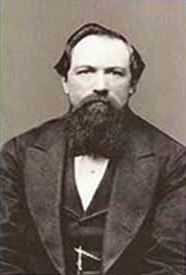
The Enduring Echoes: America’s Legends and the Men Who Keep Them Alive
America, a nation forged in relatively recent history, paradoxically boasts a legendary landscape as rich and varied as any ancient civilization. From the colossal lumberjacks of the frontier to the spectral figures haunting forgotten byways, these stories are more than mere folklore; they are the cultural bedrock upon which a national identity has been built, reflecting our aspirations, fears, and the boundless spirit of a continent. And in the heart of Maine, a figure like Sumner Pinkham offers a fascinating, salty lens through which to examine this enduring phenomenon – a living embodiment of the very spirit of storytelling that births and perpetuates these myths.
To understand America’s legends is to understand the American character. They are often tales of exaggerated heroism, of human ingenuity triumphing over impossible odds, or of the mysterious unknown lurking just beyond the civilised world. They speak to our pioneering past, our industrial might, and our persistent fascination with the unexplained. These are the narratives that children grow up with, that shape our understanding of historical events, and that continue to evolve, adapting to new eras while retaining their core resonance.
Consider the pantheon of American folk heroes. Paul Bunyan, the colossal lumberjack, whose axe carved the Grand Canyon and whose footsteps created the Great Lakes as watering holes for his blue ox, Babe. He embodies the raw power and boundless ambition of early America, conquering a vast wilderness with muscle and wit. His tales, originating in logging camps, were morale boosters, celebrating the strength and camaraderie of men engaged in backbreaking labor. Similarly, Pecos Bill, the ultimate cowboy, who tamed the wildest horses, rode a cyclone, and lassoed a rattlesnake, personifies the rugged individualism and adventurous spirit of the American West. These figures are larger than life, projections of the ideal American: strong, resourceful, and unafraid.

Then there’s Johnny Appleseed (John Chapman), a more gentle hero, whose legend is rooted in historical fact but embellished with layers of myth. He roamed the frontier, planting apple seeds and spreading kindness, embodying the spirit of westward expansion and the promise of a bountiful future. His story is one of enduring generosity and the quiet impact of one individual on the landscape and the lives of others. These frontier legends, whether factual or fantastical, served to mythologize the arduous process of settling a continent, transforming hardship into heroic sagas.
As the nation industrialized, new legends emerged, reflecting the challenges and triumphs of a changing America. John Henry, the "steel-driving man," whose epic contest against a steam-powered drill ended in his death but cemented his legacy as a symbol of human resilience against the encroaching machine age. His story is a poignant testament to the dignity of labor and the often-brutal cost of progress. Similarly, Casey Jones, the brave railroad engineer who sacrificed his life to save his passengers, became a symbol of duty, courage, and the perilous romance of the rails. These industrial heroes underscored the sacrifices made in building modern America, often at great personal cost.
But America’s legendary landscape is not solely populated by heroes. It is also a land of shadows and secrets, where the unknown stirs a different kind of myth. Bigfoot, the elusive ape-man said to roam the Pacific Northwest forests, represents our primal connection to the wilderness and the tantalizing possibility of undiscovered species. The Jersey Devil, a winged, horse-headed creature said to haunt the Pine Barrens of New Jersey, speaks to local fears and the eerie power of desolate landscapes. And the persistent fascination with UFOs and extraterrestrial life, particularly since the alleged Roswell incident, has birthed a sprawling mythology of government cover-ups, alien abductions, and humanity’s place in the cosmos. These legends tap into our anxieties, our desire for wonder beyond the mundane, and our enduring curiosity about what lies beyond the known.
These narratives, whether rooted in historical figures, cultural anxieties, or pure flights of fancy, serve a profound purpose. They are a collective memory, a moral compass, and a source of shared identity. They teach lessons about courage, perseverance, and the consequences of hubris. They provide a sense of place, giving specific landscapes and communities their own unique, often supernatural, character.
This brings us back to Sumner Pinkham. Born in 1888 on Monhegan Island, a tiny, rugged outpost off the coast of Maine, Pinkham was a fisherman, a lobsterman, and above all, a storyteller. He wasn’t a hero in the Bunyan mold, nor a tragic figure like John Henry. Instead, he was a legend in his own right, a local luminary whose wit, wisdom, and penchant for colorful exaggeration transformed the everyday into the extraordinary.
Pinkham’s genius lay not just in the content of his tales, but in their delivery. He embodied the spirit of the Yankee storyteller – laconic, observant, and with a keen eye for the absurd. His stories, often told with a twinkle in his eye and a dry, understated humor, were carefully crafted performances. He’d spin yarns about monstrous fish, harrowing storms, peculiar island characters, and the general vagaries of life on the edge of the Atlantic. These weren’t grand national epics, but intimate, local legends that resonated deeply with his audience.
One could imagine Pinkham, hunched over a fishing net, or leaning against a weathered dock, captivating a small group with a tale. Perhaps it was about the time he wrestled a particularly enormous cod, or a ghost ship seen gliding through the fog, or a particularly stubborn lobster pot that seemed to defy all logic. He understood the art of the embellishment, the subtle twist that elevates a simple anecdote to a memorable legend. As one local might have remarked, "Sumner could make a trip to the outhouse sound like an epic journey." He understood that the truth, while important, was often less compelling than a well-told lie, or at least a truth skillfully adorned.
Pinkham’s tales, though localized, resonated with the broader American tradition of storytelling. He was a keeper of local history, a chronicler of his community’s soul, and a perpetuator of the oral tradition that has sustained legends for centuries. His stories, passed down through generations of Monhegan residents and visitors, reinforced the island’s unique identity and contributed to its mystique. He proved that legends don’t always need to span continents; they can thrive in the confines of a small island, in the heart of a close-knit community.

The evolution of American legends has mirrored the nation’s own growth. From campfire stories and printed dime novels, from radio dramas to Hollywood blockbusters, and now to viral internet memes and intricate online lore, the vessel for these legends changes, but the core human need remains. The internet, in particular, has become a fertile ground for new myths – from creepypastas like Slenderman to elaborate conspiracy theories that blur the lines between fact and fiction. These modern legends, though often ephemeral, demonstrate that the human appetite for compelling narratives, for explanations of the inexplicable, and for shared stories, is as strong as ever.
What unites Paul Bunyan, John Henry, Bigfoot, and the countless tales spun by Sumner Pinkham is their power to connect us. They are the threads in the vast tapestry of American identity, weaving together diverse regions, cultures, and historical periods. They offer a shared heritage, a common language of symbols and archetypes that transcends individual experience.
In the fading light on a Maine pier, or in the hushed reverence around a campfire, the spirit of Sumner Pinkham, and the countless storytellers before and after him, ensures that the legends of America will continue to echo. They are not static relics of the past but living, breathing narratives, constantly being retold, reinterpreted, and reimagined, shaping who we are and who we aspire to be in the ongoing American story. They remind us that sometimes, the greatest truths are found not in facts, but in the enduring power of a well-told tale.


